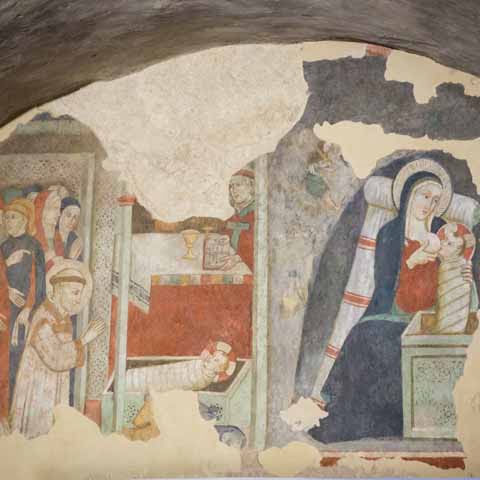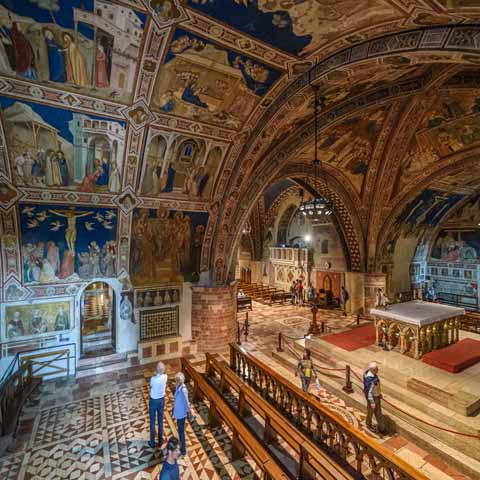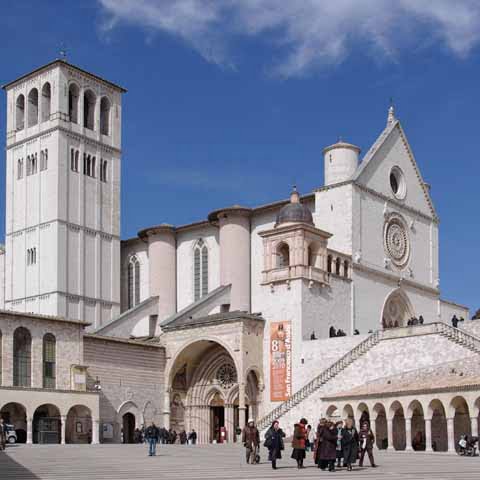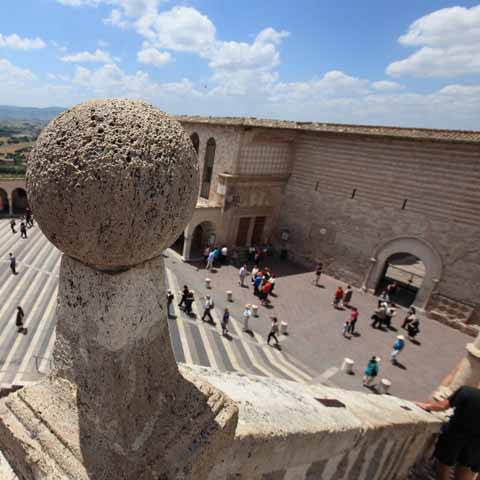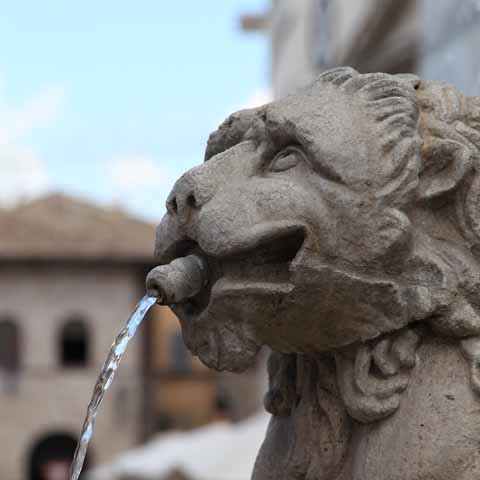Buried in the heart of Italy almost halfway between the Adriatic and Tyrrhenian Seas, is the cultural jewel of Assisi. This medieval city has roots that trace back to before the Roman occupation, and it has since become one of the most visited cities in Italy for religious pilgrimages due to its connections to Saint Francis. This saint is largely responsible for the city’s overwhelming spiritual atmosphere that can be found in local architecture, artistic masterpieces, religious writings, sacred music, and even film.
As you wander the streets of this city on a hill, take time to stroll through historical churches, view ancient religious art, and examine the spiritual components of local literature and music. Assisi may be small in size, but it is one of the most important cultural cities in Italy, featuring natural beauty and culture that is said to feed the soul.
ARCHITECTURE IN ASSISI
In 2000, UNESCO designated the Franciscan structures of Assisi as a World Heritage Site. This includes a number of local churches and religious sites such as the Basilica of San Francesco d’Assisi, Eremo delle Carceri, and the Basilica of Santa Maria degli Angeli.
The Basilica of San Francesco d’Assisi is perhaps one of the most important Franciscan structures as it is a primary stop for Christian pilgrimages in Italy. The church was built in the thirteenth century into the side of a hill. The church is recognized as having two main divisions of an Upper Church and a Lower Church, each of which is home to a number of gorgeous medieval frescoes by noteworthy painters such as Cimabue, Simone Martini, Pietro Lorenzetti, and Giotto. The church and a few of its frescoes, including some vaulted frescoes by Cimabue and Giotto in the Upper Church, were damaged during a September 1997 earthquake that struck Assisi and the surrounding area. The church was closed for approximately two years as the renovations took place.
Just next door is the Sacro Convento. This convent features more than fifty glorious Romanesque arches making it look similar to a fortress from the valley below. Like many of the structures in Assisi, it is made from the white and pink stone of nearby Mount Subasio.
The Eremo delle Carceri is located high on the hill above the town of Assisi. The word “carceri” derives from a Latin word meaning isolated places or prisons. It is aptly named as Saint Francis would often come here to think and pray in solitude. Today the area is home to a hermitage complex that has been constructed around the original spot where Saint Francis sought quiet time.
The Basilica of Santa Maria degli Angeli was built in the sixteenth century and renovated in the nineteenth. This magnificent church is just as beautiful as it is enormous and evokes a powerful feeling of reverence in visitors. Most travelers come to see the church itself and the Porziuncola, a small church where the Franciscan order began located directly underneath the church’s dome. So many pilgrims frequently came to visit this small church, that there was not enough room to accommodate them, hence the construction of the much larger basilica. The Porziuncola, measuring just 13 feet by 23 feet, is considered to be the most sacred of spaces for Franciscans and is home to stunning frescoes as well as historic architecture.
The Basilica of Santa Chiara, is dedicated to another important saint of the city, Saint Clare of Assisi, a follower of Saint Francis. This historical thirteenth century church with Gothic architecture features gorgeous frescoes and paintings. Today the church houses Saint Clare’s remains as well as the crucifix that is believed to have spoken to Saint Francis.
The Cathedral of San Rufino is estimated to have been built in the twelfth century upon a site that was previously home to other churches as well as an Ancient Roman forum. One of this church’s largest claims to fame is the fact that it was the baptismal site of both Saint Francis and Saint Clare of Assisi. The church was constructed with the gorgeous pink and white stone from Monte Subasio. The building has three main levels, three rose windows, three entryways, a main steeple, and a bell tower. Do not miss the stunning chapels and artwork housed inside.
One of the most prominent Roman legacies in Assisi is the Temple of Minerva. The structure is estimated to have been built in the first century BC and yet has survived the test of time remarkably well. The façade of this mostly white structure features six large columns that brace Corinthian capitals. Located just inside the temple is the Church of Santa Maria Sopra Minerva, which was established in the sixteenth century.
Situated upon a hill overlooking Assisi is the imposing fortress of Rocca Maggiore. The earliest written documentation of the fortress can be traced back to 1174, though the original structure may have been even older. With such a long and varied history, the fortress underwent several periods of construction and reconstruction. After being destroyed in 1198, it was rebuilt in 1365 under the direction of Cardinal Egidio Albornoz to serve as a lookout post. Rocca Maggiore was then modified and expanded in the following centuries before being abandoned in the seventeenth century. Once perfectly positioned to defend the town, today Rocca Maggiore offers splendid panoramic views of Assisi and the surrounding valley.
ART IN ASSISI
With much of the city of Assisi being dedicated to the religious structures that UNESCO designated as a World Heritage Site, it only makes sense that the city’s best art can be found on or within these same structures.
Two famous artists, Pietro Lorenzetti and Simone Martini, spent time in Assisi painting, and some of their art can be found within the walls of the Basilica of San Francesco d’Assisi. One of Lorenzetti’s better-known works is a fresco found in the in Lower Church that has panels depicting the crucifixion of Jesus, the deposition from the cross, and the entombment of Christ. Martini is credited with the frescoes present in several of the Basilica’s chapels, including the San Martino Chapel, which is dedicated to Saint Martin of Tours.
Another masterpiece in the Basilica of San Francesco d’Assisi is the series of frescoes painted by Giotto. Born in Tuscany, Giotto was considered to be one of the greatest artists of his time. In addition to Assisi, Giotto was active in Rome, Padova, Florence, and Naples. Located in the Upper Church of the Basilica of San Francesco d’Assisi, visitors will be amazed by the series of 28 frescoes by Giotto depicting the life of Saint Francis.
The Basilica also houses several important works by maser artist Cimabue, including Maestà with Saint Francis and Crucifixion.
In addition to its frescoes and paintings, Assisi is widely regarded throughout Italy and the rest of the world for its artisan craftwork. Many local workshops are dedicated to traditional artistic mediums including ceramics, wrought iron, and woodworking. The town is also known for remarkable religious sculptures, goldsmithing, and antique restoration.
A special mention goes to the craft of embroidery, which in Assisi dates back to the thirteenth century. During this period, simple designs and motifs were developed in monasteries and used to create religious objects. The tradition flourished in Italy during the Renaissance before declining in subsequent centuries. After its rediscovery in Assisi during the twentieth century, this style of embroidery was linked to the town by name. The defining characteristic of this style is the fact that the subjects of the work are not stitched, but rather outlined. When strolling through the historic streets of Assisi, it is not unusual to see women enjoying the weather as they sit outside their homes completing embroidery projects.
LITERATURE
Perhaps the most renowned literary authors from Assisi are the historical spiritual leaders of Saint Francis and Saint Clare. Saint Francis is credited with founding a spiritual group for men called the Franciscan Order, and Saint Clare is credited with founding a spiritual group for women called the Order of the Poor Ladies.
Both of these individuals were instrumental in linking Assisi with spreading the Word of God. They were often reflective in quiet time and spent hours in contemplation. Eventually, both of these saints put their prayers, letters, and spiritual musings to paper. These works are still available today. Of particular renown is the Canticle of the Sun, which was composed by Saint Francis and is considered to be one of the oldest written texts in the Italian language, if not the very first work of Italian literature.
It is worth noting that while both of these saints contributed to the literary movement in Assisi by writing, perhaps posthumously they are still doing the same through others’ writings. Today hundreds of books exist on Saint Francis and Saint Claire, creating a platform to convey their thoughts and missions to entirely new generations. A few notable works about the life of Saint Francis have been written by Raoul Manselli, G.K. Chesterton, Zofia Kossak, Nikos Kazantzakis, Donald Spoto, and John Tolan.
In addition to Saint Francis and Saint Clare, a major Roman poet named Sextus Propertius was born in Assisi when it was under Roman dominion and called Assisium. Unfortunately, the majority of Propertius’ works did not survive, with the exception of four books of Elegies.
MUSIC
As with most culture and tradition in Assisi, even music can be traced back to its most renowned resident, Saint Francis. The saint is said to have prayed by singing his praises to the Lord. Largely because of this religious tradition, the city has hosted the Assisi Pax Mundi Franciscan Music Festival. This festival’s purpose is to create an awareness of sacred music with the help of roughly a dozen choirs and hundreds of participants who perform at various religious locations throughout the city.
During the summer, events such as Assisi Performing Arts and the Assisi Music Festival (MUSA) celebrate a love for music. These events are generally for vocalists and instrumentalists from across the globe and cover various genres of music such as opera, orchestra, pop, jazz, and more. Many of these celebrations of music also include class instruction, lectures, and exhibitions.
CINEMA
The city of Assisi is largely on the radar of pilgrims and travelers because of the fascination with and loyalty to Saint Francis. Although this man came from humble beginnings long ago, his simple message of Christ’s love for all is still alive and well. Throughout the years, several films have been made about the Saint, his life, and his Christian beliefs and have been filmed in part, if not entirely, in his birthplace of the small town of Assisi. Examples include The Flowers of St. Francis directed by Roberto Rossellini, Brother Sun, Sister Moon directed by Franco Zeffirelli, and Francesco, a 1989 film starring Mickey Rourke and Helena Bonham Carter.
Though today it is a relatively small town, Assisi’s rich history and association with Saint Francis have cemented its cultural importance. Do not miss your chance to visit the town of Saint Francis and admire the treasures within—you will not be disappointed.
Don't just see Italy, live it.
Your dream trip to Italy has never been closer
No more endlessly scrolling travel sites. Our travel experts will craft the perfect, one-of-a-kind trip just for you.

300+
DESTINATIONS
We offer more Italian destinations than any travel site. Do and see more with Trips 2 Italy.
1 (of a kind)
ITINERARIES
Because your dream trip to Italy should be designed for you, not for the masses.
100%
PEACE OF MIND
From flights and accommodations, to food and activities - we take care of every detail.
